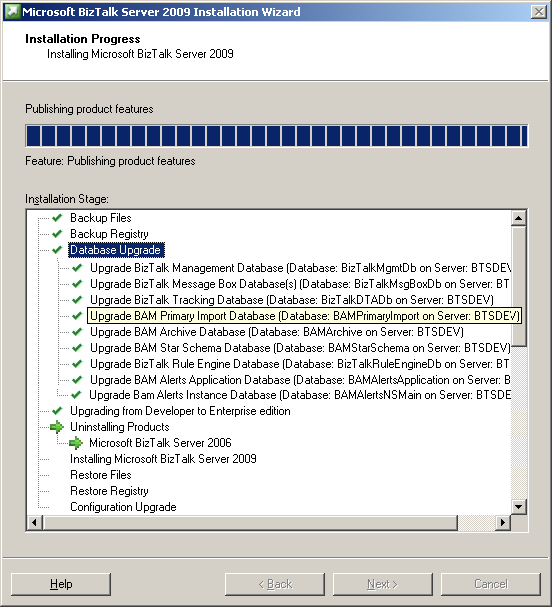Originally posted by Nick Heppleston at: http://www.modhul.com/2009/01/04/upgrading-biztalk-server-2006-r2-to-biztalk-server-2009/
In this post, I’ll quickly walk through upgrading a production BizTalk 2006 R2 installation to the latest BizTalk 2009 Beta release.
Prerequisites
The only prerequsite for an upgrade is the .Net 3.5 Framework (link) and the framework must be manually installed before starting the upgrade process. Although the provision for an automagic installation appears to be available, it is not enabled in this beta release.
The Upgrade Process
When the installer runs you need to provide the usual licence key and accept the licence agreement itself. Prior to performing the actual upgrade, you will be prompted to confirm the upgrade details. A few points of interest are at this stage are:
- All BizTalk Host Instances must be stopped and the BizTalk databases backed-up.
- Several features are not available in BizTalk Server 2009, including: Human Workflow, The BizTalk Deployment Command Line Tool (btsdeploy.exe) and MSMQT – I’m pleased to see that the MSMQT implementation has been dropped and that Microsoft have finally removed BtsDeploy.exe after it was superseeded by BtsTask.exe in BizTalk 2006.
- A Developer Edition of BizTalk Server 2006 R2 will be upgraded to BizTalk Sever 2009 Enterprise Edition – I don’t know if this is a beta feature or not (i.e. will the same happen with BizTalk Server 2006 R2 Branch Edition?)
- All BizTalk and BAM databases are upgraded.
Once you are happy with the upgrade details, the installer will proceed as shown in the screenshot below (I’ve enhanced the screenshot here to show the full upgrade process, so please excuse my Paint abilities):

With the upgrade complete, we now have a BizTalk 2009 Start Menu entry, containing the usual BizTalk Admin Console, BizTalk Server Configuration, Business Rules Composer etc. Interestingly, we retain a BizTalk Server 2006 Start Menu entry containing a link to the BAM Portal website. We don’thowever have a new directory in Program Files, although the contents of this directory have been updated to the BizTalk Server 2009 binaries. I’m presuming that both of these are beta issues that will be resolved in the RTM version.
Comparing an upgrade with a previous BizTalk 2006 R2 installation
Its interesting to compare an upgrade with an old installation: looking through the resources deployed in the BizTalk.System and BizTalk.EDI applications – even though one or two have been removed – of those that remain the assembly versions have not changed. Furthermore, existing custom Applications, Send Ports and assemblies are preserved.
Running existing BizTalk 2006 R2 Applications following an upgrade
Prior to the upgrade I deployed a very simple orchestration-based project and I’m very pleased to see that following the upgrade, this project works exactly the same in 2009 as it did in 2006 R2 – without modification. This is excellent news and means that there is little – if any – work that needs to be done to a 2006 R2 project before migrating to BizTalk 2009.
Conclusion
In conclusion, the upgrade process is very straightforward for anyone experienced with the BizTalk installer – there is no need for re-configuration, however only the BizTalk 2006 R2 elements of functionality that are installed will be upgraded. There are still a few rough edges that need to be worked on, but this is expected from a beta product.

![Reblog this post [with Zemanta]](https://i0.wp.com/img.zemanta.com/reblog_e.png)

 Just a quick post to say Happy New Year to all of the BizTalk community. I was planning on writing about the BizTalk 2006 R2 to 2009 upgrade experience, but I managed to forget my external drive so I can’t start the VM… instead you’ll have a settle with a beautiful picture of York Minster (I’m currently back home in Yorkshire enjoying the New Year celebrations with the family).
Just a quick post to say Happy New Year to all of the BizTalk community. I was planning on writing about the BizTalk 2006 R2 to 2009 upgrade experience, but I managed to forget my external drive so I can’t start the VM… instead you’ll have a settle with a beautiful picture of York Minster (I’m currently back home in Yorkshire enjoying the New Year celebrations with the family).